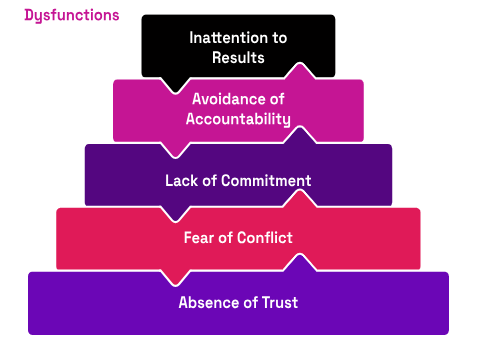Here we explore at how Lencioni’s 5 Dysfunctions of Teams materialise differently within different team types.
Patrick Lencioni’s “The Five Dysfunctions of a Team” is a popular model for understanding the common pitfalls that can hinder a team’s success. However, the way these dysfunctions manifest and their impact can vary significantly depending on the nature of the team.
In this blog post, we’ll delve into how Lencioni’s 5 dysfunctions play out differently in Inter-Dependent and Extra-Dependent teams.
Inter-Dependent vs. Extra-Dependent Teams: A Quick Recap
Before we dive into the dysfunctions, let’s recap the key differences between these two types of teams. Inter-Dependent teams (IDTs) are characterised by a reliance on each other’s different skills and roles to achieve a common goal. Members must collaborate closely, with their individual efforts tightly intertwined. It means they work closely together, often at the same time. Think of a surgical team or a product development team.
Extra-Dependent teams (EDTs), on the other hand, have members who can perform their tasks independently without relying on others. This is because they share similar roles and skills and mostly work with people outside the team. It’s the dependence outside the team that gives them their name: Extra-Dependent. It means they function as a team by working separately, with time together being much rarer than an Inter-Dependent team. In Extra-Dependent teams, the team goal is generated through aggregation of members’ individual performances. Examples include sales teams or teams of project managers.
Now let’s take a look at each of Lencioni’s 5 dysfunctions. Visualised as a pyramid it outlines five common team problems that hinder effectiveness. We’ll start at the top, where the dysfunction is least influential. As we work our way through, the impact of the dysfunction becomes greater. Take time to check out the differences between Inter-Dependent and Extra-Dependent Teams.
Lencioni’s 5 Dysfunctions of Teams

Dysfunction 5: Inattention to Results
Teams that don’t measure or regularly review the result of their work are unlikely to perform because they don’t understand the results that are required. This is relatively easy to solve, so long as all the lower functions are working. But often they are not.
Results in Inter-Dependent Teams
The common goal in an IDTs is the primary result to attend to. When team members prioritise individual goals over the team’s objectives, it can lead to a lack of collaboration, unhealthy competition, and a decrease in overall performance.
Results in Extra-Dependent Teams
By contrast, team results in an EDTs are an aggregation of individual outcomes – like total sales in a sales team. Attention to everyone’s individual results creates the whole team result, so paying attention to individual results is important.
In both teams, inattention to results is dealt with through accountability. But in each team, accountability is done differently.
Dysfunction 4: Avoidance of Accountability
If team members don’t feel accountable for their contributions, and aren’t held accountable, they won’t pay attention to their results. Accountability isn’t about pointing fingers or blaming, but it is about following up on what people are responsible for and providing some support, encouragement or challenge. And how teams hold themselves accountable is different depending on the type of team.
Accountability in Inter-Dependent Teams
Accountability is mutual within IDTs. This means everyone has equal responsibility for goal achievement. When team members avoid holding each other accountable, it can lead to resentment, a decline in performance standards, and an overall sense of unfairness. Whilst team members contribute different skills and roles, it’s the combination of them all which is required to achieve the team goal. So when someone isn’t performing in an IDT, it affects everyone else because they all depend on each other. Accountability means providing anything between tough feedback and supportive empathy to colleagues in order to help them through a difficult time.
Accountability in Extra-Dependent Teams
In EDTs, accountability is no less important, but is more individual when it comes to results – because typically people are working separately from each other. But accountability is also about the shared practice. The team needs to follow similar processes, using similar skills and understanding common knowledge. Accountability involves the best practitioners sharing what makes the difference for them, and the rest of the team learning from it. When EDTs don’t meet up, or when individual members decide their external stakeholders are more important, this is a time to hold them accountable.
Team Coaching with You
Contact us to explore how team coaching can realise your team’s needs and aspirations.
Dysfunction 3: Lack of Commitment
Teams that don’t care and don’t know what they are trying to achieve, therefore, don’t know what they are accountable for. There is ambiguity in what they are teaming for and their level of commitment to each other.
Commitment in Inter-Dependent Teams
Decisions that are made in IDTs need to involve everyone, because everyone affects everyone else. Coordination of effort needs to care for everyone in the team. It needs to bear in mind a commitment to the team’s goal and a care for everyone’s contribution towards it. A lack of commitment to the goal and to each other, can lead to ambiguity, confusion, and a lack of direction, ultimately derailing the team’s efforts.
Commitment in Extra-Dependent Teams
In EDTs, a lack of commitment is likely to show up as an individual’s prioritisation of their work outside the team. Because there is little interdependence between members, the impact of commitment elsewhere is less immediate. Indeed it can often be seen as prioritising the “customer”. But this lack of commitment to the Extra-Dependent Team has a longer-term impact. When members don’t commit to the strengthening and improvement of the team’s common practice, a commitment to learning with each other, from each other, for each other, the team remains only a group of individuals. It fails to combine the best of each other to achieve higher performance.
Dysfunction 2: Fear of Conflict
Disagreement is a vital ingredient in performing teams. Where disagreement is considered conflict, and therefore feared, important disagreements are avoided and decisions are made in isolation or without the benefit of the whole team’s input.
Conflict in Inter-Dependent Teams
IDTs need to fully explore the goals they wish to achieve, the ways they work together to achieve it and how they coordinate those efforts. Because of their differences, certain decisions by the team will affect members in different ways and so a full understanding of the implications of any decision needs to be considered. Healthy conflict is essential for exploring the different perspectives and challenging assumptions so that well-informed decisions are made. Inter-Dependent teams that shy away from conflict miss out on the transparency of such open disagreement. This leads to decisions being made by individuals rather than the team – meaning the potential synergy of the team isn’t being realised.
Conflict in Extra-Dependent Teams
In EDTs, a fear of conflict shows up as false agreement, and often that agreement is in the form of a common “enemy” outside the team – often a stakeholder or stakeholders. The focus of attention outside the team means that disagreements inside the team. Disagreements about standards of practice, the quality of dialogue, or commitments to each other’s learning for instance – are avoided. It creates a false harmony that is a pseudo team, but fails to move beyond the individual level. This can lead to missed opportunities for growth and a lack of innovation within the team, the common practice and the value it adds outside the team.
Dysfunction 1: Absence of Trust
Teams that don’t trust each other, can’t have the disagreements they need in order to combine their full capabilities. And commit to being accountable for results that they truly desire together. Trust is the most powerful bond for any team and also the most powerful dysfunction. If there is an absence of trust within the team, all the other functions are affected. But an absence of trust shows up differently in Extra-Dependent and Inter-Dependent teams.
Trust in Inter-Dependent Teams
An absence of trust in an IDT undermines everything the team is there for. There is no belief in each other’s abilities to deliver the team goal – abilities that each of the team depend on in an Inter-Dependent team. In an IDT that has an absence of trust, defensive behaviours are habitual. Team decisions are negotiated outside the room and rubber stamped without discussion because there is no safety in disagreeing. Vulnerability is pounced on as an opportunity to score points, so people armour themselves for team discussions and meetings, protecting themselves from harm and therefore minimising teamwork and productivity. All this extra work and emotion is exhausting, incredibly inefficient and inevitably ineffective. As a result accountability defaults to individual “deliverables” and demonstrations of effort over outcomes. It’s a toxic and debilitating environment.
Trust in Extra-Dependent Teams
Absence of trust within an EDT is just as toxic, but the separate working of members makes addressing it more avoidable. If teammates don’t trust each other, they make excuses for not turning up to meetings. They simply rely on themselves to do the work their stakeholders depend on. Extra-Dependent teams can sometimes try to build trust by getting to know each other better. But trust in an Extra-Dependent team is more than telling your story and asking about family, etc. Trust is really only present in an Extra-Dependent team when members open up to each other about how they do their work, here, now. Trust is about being vulnerable to each other, about doubts, mistakes, concerns, but also successes and strengths.
Strengths in an Extra-Dependent team are to be shared (the opposite of in an Inter-Dependent team where strengths is the difference a team member contributes). Sharing a strength is one of the most trusting acts a team member can do in an Extra-Dependent team. They are giving away what gives them the edge over their peers.
In teams where this edge is rewarded – bonuses for highest achiever for instance – it encourages that member to withhold from the rest of the team what makes their difference. Sharing strengths, mistakes, challenges, is an act of vulnerability which builds deep trust within an Extra-Dependent team. As that trust affects the performance of the team, they realise the rest of the team has their back.
Conclusion
Lencioni’s 5 Dysfunctions of Teams provides a simple and valuable framework for understanding the challenges that teams face. However, a belief that all teams experience these dysfunctions in the same way will lead to more dysfunction. By understanding how Lencioni’s 5 dysfunctions materialise differently within Inter-Dependent vs Extra-Dependent teams, leaders can be more aware of what to look out for in their specific type of team and be ready to take action to enable the team to achieve greater functionality.
And that will enable you to lead well.
If you haven’t done so, take our Team Dependency Diagnostic. This unique tool measures functionality of teams as well as team inter-dependency and team extra-dependency.


